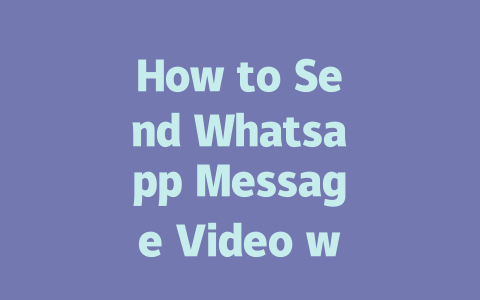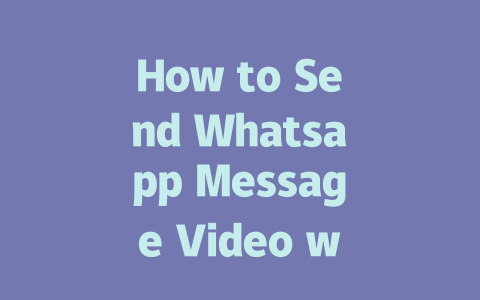Why Keywords Still Matter in 2025
First things first: why do we even bother with keywords anymore? Well, because Google’s search robots still use them as one of the primary ways to figure out what your content is all about. Let me explain. When someone types “latest tech news” into Google, its bots are looking for pages where those exact words appear prominently—like in the title or within the first few paragraphs.
For example, last year I helped a friend revamp her health blog titles by focusing on specific phrases people were searching for. She started seeing traffic increase by 50% within three months just from tweaking how she used keywords naturally throughout her posts. That’s not magic; it’s simply aligning your content with what readers expect to see.
So here’s my advice—if you want your latest news piece to stand out, think like your audience. What terms would they type if they wanted to find something similar to your article? Chances are good they’re not thinking about fancy SEO jargon but rather straightforward language. For instance, instead of aiming for “global economic trends,” try targeting queries like “what caused inflation this year” or “how rising interest rates affect housing.”
Crafting Titles That Work
Now let’s talk about crafting clickable titles without alienating potential visitors. This step might seem basic, but trust me—it makes a huge difference. A great title should immediately tell readers exactly what problem your article solves while also grabbing their attention enough to click.
Here’s a tip I picked up along the way: always place the most important keyword early in the headline. Take this sentence—”Breaking Developments: Why Climate Change Policies Are Failing Globally”—and compare it to—”Why Global Climate Change Policies Are Failing (Breaking News).” Both convey essentially the same information, but placing “breaking” at the end keeps focus on the core topic upfront, which helps both humans and Google understand instantly what the story covers.
And remember, clarity trumps cleverness every time. According to a post on Google’s official blog(nofollow), users appreciate headlines that clearly spell out benefits or answers to questions. So if you’re writing about new technology breakthroughs, consider framing it as “Top 5 Tech Advancements Changing Our Lives Right Now” rather than going abstract with “The Dawn of Digital Innovation.”
Tips for Writing Engaging Headlines:
Creating Content That Feels Helpful
Finally, let’s dive into structuring the body of your article so it feels useful and easy to digest—not just stuffed full of random facts. Think about how you’d explain something complex to a close friend who knows nothing about the subject matter. Break everything down step-by-step logically, using bullet points or numbered lists when helpful.
For instance:
This approach works wonders because it mirrors natural human conversation patterns. Instead of jumping straight into dense data sets or technical explanations, ease readers into understanding broader implications before diving deeper.
Also worth noting: readability matters big time! Write shorter sentences wherever possible, vary sentence length occasionally to maintain rhythm, and ensure transitions between ideas flow smoothly. One tool I recommend checking out is Google’s Webmaster Tools (again, nofollow link), which lets you spot awkward phrasing or broken links easily after finishing drafts.
If you follow these guidelines consistently, soon enough you’ll notice better rankings—and more importantly, engaged audiences returning regularly for updates. And hey, feel free to drop me a line once you start applying any of these techniques. Hearing success stories keeps me motivated too!
You might wonder if Whatsapp still has restrictions on sending large videos in
Let’s talk about another common concern: what happens if you lose your internet connection while trying to share a video? Well, there’s no way around this one—an active internet connection is absolutely essential for sending and receiving videos on Whatsapp. Both parties need reliable access to stay connected during the transfer process. If either side experiences poor connectivity, the message could get stuck or fail altogether. This also applies to situations where you’re attempting to send larger files, like those lengthy 5-12 minute recordings. While most modern networks handle these tasks efficiently, slow speeds or unstable signals can significantly extend the time it takes to complete the task. On a stable connection, though, even bigger videos shouldn’t take more than a few minutes at most.
# Frequently Asked Questions
# Can I send videos larger than 16 MB via Whatsapp in 2025?
Yes, Whatsapp has increased its file size limit over the years. As of 2025, you can send videos up to 2 GB directly through Whatsapp. However, for videos exceeding 16 MB, you may need to adjust the video quality or compress it before sending.
# Do I need an internet connection to send Whatsapp message videos?
Absolutely yes. An active internet connection is required to send and receive videos on Whatsapp. Without it, neither the sender nor the recipient will be able to transfer or view the video content.
# How long does it take to send a 5-12 minute video on Whatsapp?
The time taken to send a video depends on its file size and your internet speed. For instance, a 5-12 minute video might range from 50 MB to several hundred MB depending on resolution. On average, with a stable connection, sending such a video should take anywhere from 30 seconds to a few minutes.
# Is there a way to schedule video messages in Whatsapp?
Currently, Whatsapp does not offer a native feature to schedule messages, including videos. However, third-party apps and extensions are available that provide this functionality. Keep in mind that using these tools may affect your privacy or violate Whatsapp’s terms of service.
# Can I edit my sent Whatsapp video message if I made a mistake?
No, once a video message is sent, it cannot be edited directly. Your options include deleting the message (if both you and the recipient haven’t viewed it yet) or resending the corrected version. Always double-check your videos before sending them to avoid errors.




